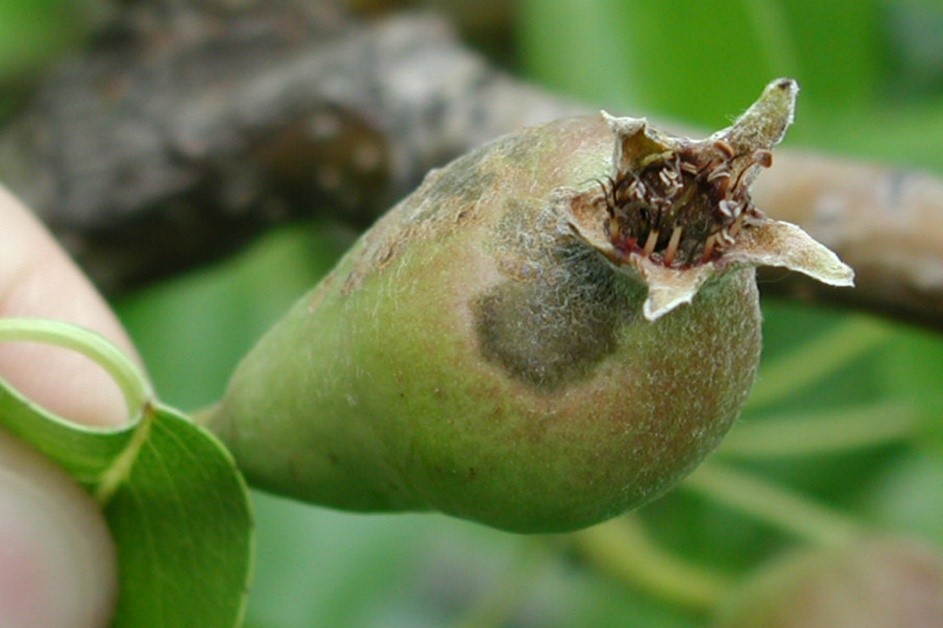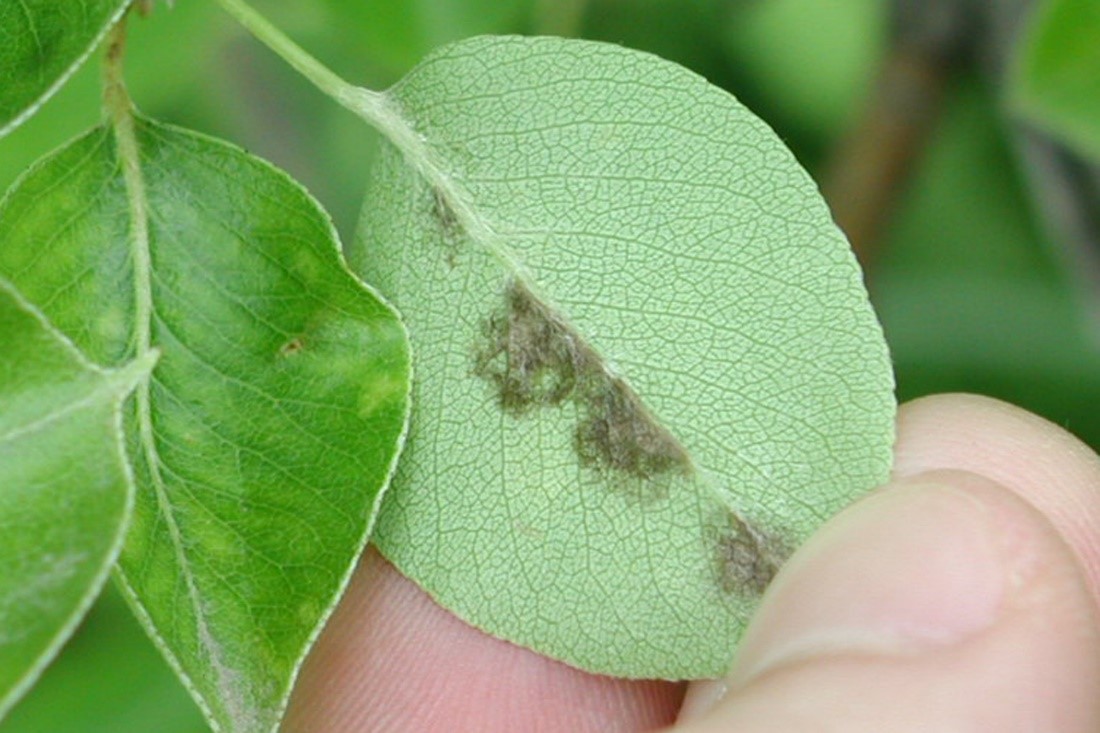Pear scab
Pear scab, or black spot, is the most serious and widespread fungal disease of pears. It's caused by the fungus Venturia pirina and infects:
- leaves
- shoots
- blossoms
- fruit.
It can cause serious crop loss, especially in wet seasons when control measures are inadequate. Control of the disease depends mainly on costly spraying programs.
The disease is found worldwide, wherever pears are grown. The fungus is closely related to apple scab. But, though the diseases are similar, infection can't cross between them.
Symptoms of pear scab
The symptoms of pear scab are very similar to those of apple scab:
- Fruit infections appear as olive-green to black spots (see Figures 1 and 2).
- Early infections cause large spots that distort the fruit (see Figure 3), while later infections cause smaller, more superficial spotting.
- As with apple scab, infections immediately before harvest may produce very small black spots that develop on fruit during storage (storage scab).
- Leaf infections, which are less common than in apple scab, frequently occur on the underside of leaves (see Figure 4).
- Twig infections, on the other hand, are more common than in apple scab. They appear as small oval blisters on the affected shoot.


Disease cycle
The disease cycle of pear scab is similar to apple scab. The main difference is that, under Victorian conditions, shoot infections on pears are more common than on apples.
These shoot infections can provide the fungus with another means of overwintering. Though overwintering as ascospores in dead leaves under trees is still the most important source of primary inoculum.
Shoot infections are common on:
- Winter Nelis
- Beurre Bosc.
But are less common on:
- Williams' Bon Chretien
- Packham's Triumph.
Infection periods (the time that leaves or fruit must remain wet for infection to occur) of pear scab are similar to those described for apple scab, though few detailed studies have been carried out to confirm this.


Controlling pear scab
Principles of control are very similar to those for apple scab.
Control is based on a protectant spray program, supplemented by post-infection and autumn eradicant sprays. The period from delayed green tip to petal fall is most important in preventing infection. This corresponds with the period of greatest discharge of ascospores.
- Apply the first spray when one-third of buds reach the stage of delayed green tip.
- Apply the second spray about 5 to 7 days later.
- Apply the third spray about 10 to 14 days after the first.
- Apply a fourth spray at petal fall.
Growing plant tissues could become exposed during infection periods in showery weather, and you might need:
- a fifth spray between delayed green tip and petal fall
- a post-infection spray.
Cover sprays applied at 10 to 14 day intervals after petal fall might be necessary if primary infection has occurred, and if wet weather favourable to infection persists. During dry summer weather no further sprays are necessary. But, if an infection period does occur, the use of an appropriate protectant spray before the wet period, or a post-infection spray shortly after it, should prevent development of summer scab.
Similarly, infection periods immediately before harvest might make sprays necessary to prevent the development of storage scab.
Note that you must apply post-infection sprays within several days of an infection period. For maximum effect apply them as soon as the weather clears after such a period.
Farm hygiene
When scab has been difficult to control, use sanitation practices after harvest to reduce the carryover of the fungus into the next season. Some practical sanitation practices are:
- treating leaves on the tree immediately before leaf fall with a nitrogenous fertiliser to hasten leaf breakdown
- mulching the leaf litter after leaf fall by sweeping and then using a mechanical shredder, slasher or flail mower to chop leaves into small pieces, which then break down more rapidly
- combining leaf mulching with a ground application of a nitrogenous fertiliser.
When planning your scab spray program, include at least 2 fungicides with different modes of action. This minimises the risk of fungicide resistance.
Consult with chemical resellers for the fungicides and spray timing that's most appropriate in your situation.
Monitor for potential overwintering scab
Check levels of leaf infection in all blocks after harvest to estimate the potential level of scab that can overwinter and initiate primary infection in the following spring.
Reporting an unusual plant insect pest or disease
Report any unusual plant pest or disease immediately using our online reporting form or by calling the Exotic Plant Pest Hotline on 1800 084 881. Early reporting increases the chance of effective control and eradication.
Please take multiple good quality photos of the pests or damage to include in your report where possible, as this is essential for rapid pest and disease diagnosis and response.
Your report will be responded to by an experienced staff member, who may seek more information about the detection and explain next steps.
Report onlinePhoto credits
Figure 1: Pear scab on young pear fruit. Courtesy of Dr W Turechek, USDA-ARS.
Figure 2: Pear scab lesions on fruit. Courtesy of Bruce Watt, University of Maine, Bugwood.org
Figure 3: Pear scab lesions on fruit causing deformation. Courtesy of Bruce Watt, University of Maine, Bugwood.org
Figure 4: Pear scab on the underside of a leaf. Courtesy of Dr W Turechek, USDA-ARS.